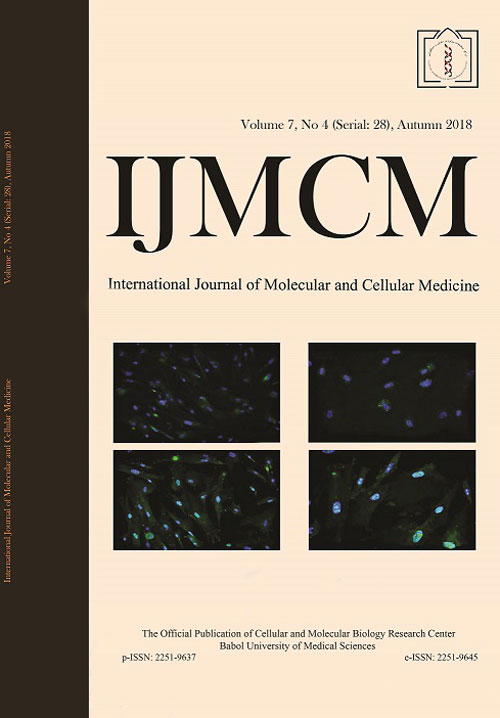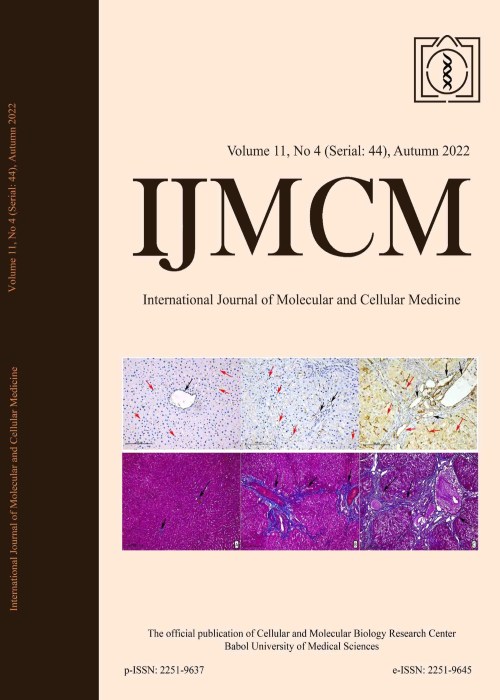فهرست مطالب

International Journal of Molecular and Cellular Medicine
Volume:8 Issue: 31, Summer 2019
- تاریخ انتشار: 1399/01/11
- تعداد عناوین: 7
-
-
Pages 169-178
Charcot-Marie-Tooth disease (CMT) is the most common hereditary neuropathy of the peripheral nervous system with a wide range of severity and age of onset. CMT patients share similar phenotypes which make it often impossible to identify the disease types based on clinical presentation and electrophysiological studies alone. In recent years, novel genetic diagnostic approaches such as whole exome sequencing (WES) has provided a ground for accurate diagnosis of CMT through identification of the disease-causing mutation(s). In the present study, that approach was effectively employed. Two unrelated large pedigrees with multiple affected cases of various pattern of inheritance (one autosomal dominant and one X-linked) were included. Clinical and electrophysiological data were obtained. DNA sample from each pedigree’s proband was subjected to WES. Data analysis was performed using an in-house developed pipeline, adopted from GATK and ANNOVAR. Candidate variant segregation was evaluated by PCR-based Sanger sequencing. A known but extremely rare (unreported in the Middle Easterners) mutation in BSCL2 (c.C269T:p.S90L) as well as a novel hemizygous variant in GJB1 (c.G224C:p.R75P) were identified and segregations were confirmed by Sanger sequencing. This study supports effectiveness of WES for genetic diagnosis of CMT in undiagnosed families.
Keywords: BSCL2, GJB1, Whole Exome Sequencing, Iranian Charcot-Marie-Tooth patients -
Pages 179-190
Homozygous mutations of PROS1, encoding vitamin K-dependent protein S (PS), have been reported so far to be associated with purpura fulminans, a characteristic fatal venous thromboembolic disorder. The current work for the first time reports the clinical phenotype in patients with juvenile retinitis pigmentosa harboring a novel likely pathogenic variant in thePROS1 gene. Whole-exome sequencing was performed on the probands of a cohort with inherited retinal disease. Detailed phenotyping was performed, including clinical evaluation, electroretinography, fundus photography and spectral-domain optical coherence tomography. Analysis of whole-exome and Sanger sequencing led to the identification of a homozygous missense substitution (c.G122C:p.R41P) in PROS1 in affected individuals from two unrelated consanguineous families of Persian origin which had classic retinitis pigmentosa with no history of the venous thromboembolic disorder. This variant was segregated, fully congruous with the phenotype in all family members. Consistently, none of 1000 unrelated healthy individuals from the same population carried the mentioned variant, according to the Iranian national genome database (Iranome) and additional in-house exome control data. This study provides inaugural clinical traces for different roles of PS as a ligand for TAM receptor-mediated efferocytosis at the retinal pigmented epithelium; the R41P variant may affect proper folding of PS needed for γ-carboxylation and extra-cellular secretion. That conformational change may also lead to defective apoptotic cell phagocytosis resulting in postnatal degeneration of photoreceptors.
Keywords: Retinitis pigmentosa, RP, PROS1, protein S, TAM receptor, efferocytosis, apoptosis -
Pages 191-199
The synovial-lining cells have been involved with rheumatoid arthritis (RA) through the secretion of various cytokines and chemokines. Increased levels of these cytokines and chemokines are seen first in the synovial and subsequently in the bloodstream of RA patients. The synovial and circulating levels of CXCL8, CXCL12, and CXCL13 are higher in the RA patients than in the healthy subjects, causing migration of immune cells to the joints, which is associated with increased joint destruction. We aimed to evaluate the effects of autologous mesenchymal stem cells intravenous administration on plasma levels of CXCL8, CXCL12 and CXCL13 at 1, 6, and 12 month follow-up periods in refractory RA patients. 13 patients with refractory RA received autologous mesenchymal stem cells (MSCs). The ELISA technique was used to evaluate the plasma level of these chemokines. CXCL8 levels were significantly decreased at month 6 after MSCs transplantation in comparison with pre-injection level, and the concentration of this chemokine was significantly increased at month 12 in comparison with the month 6 after injection (P < 0.05). The levels of CXCL12 and CXCL13 were insignificantly decreased at months 1 and 6 after the MSCs transplantation. The interaction of MSCs after migration to the inflamed joints with CXCL8-producing cells could be one but not the only possible mechanism that reduces its production in the joints and subsequently in the plasma of RA patients. CXCL8 reduction as a consequence of MSCs application returned to pre-injection levels after 12 months. Therefore, increasing the dose of MSCs and replication of injections may maintain the potential anti-inflammatory effects of MSCs on the production of CXCL8 as an inflammatory mediator in patients with refractory RA.
Keywords: Rheumatoid arthritis, mesenchymal stem cells transplantation, CXCL8, CXCL12, CXCL13 -
Pages 200-210
Breast cancer is the most common type of cancer among women. Chemotherapy is one of the main methods of breast cancer treatment, but this method is increasingly affected due to drug resistance. One of the newly discovered factors associated with drug resistance in cancer cells is interleukin receptor-associated kinase 1 (IRAK1). The aim of this study was to investigate the relationship between IRAK1 inhibition and sensitivity to methotrexate (MTX). Effects of various concentrations of MTX and constant concentration (1μg/ml) of IRAK1/4 inhibitor was examined on MCF-7, BT-20, BT-549, MB-468 cell lines. Cell viability was examined by water-soluble tetrazole -1, and cell apoptosis by flow cytometry. The expression of IRAK1 and BCRP genes was also assessed by the real-time PCR method. IRAK1 inhibitor decreased IC50 in all examined cell lines, but the most prominent effect was observed in MB-468. 72 h incubation of cell lines with IRAK inhibitor and MTX, significantly increased the annexin-V and annexin-V/7AAD positive cells, suggesting an apoptotic effect of IRAK on all examined breast cancer cell lines. RT-qPCR test results showed that the IRAK inhibitor had no effect on the expression of BCRP at any time. Our results showed that the IRAK inhibitor can increase the chemosensitivity of breast cancer cell lines without effect on BCRP mRNA expression. IRAK inhibitor in combination with MTX can induce apoptosis in breast cancer cell lines.
Keywords: Drug Resistance, Breast Cancer, Methotrexate, IRAK inhibition -
Pages 211-222
Hematological malignancies remain one of the leading causes of death worldwide despite advances in cancer therapeutics. Newcastle disease virus (NDV) is a member of Paramyxoviridae that elicits considerable interest as an anticancer agent because it can replicate up to 10 000 times faster in human cancer cells than in most normal cancer cells. Several NDV strains reportedly induce the cytolysis of cancerous cell lines. The attenuated Iraqi strain (AMHA1) of NDV is a novel oncolytic agent with promising antitumor characteristics, including apoptosis induction. This study aimed to evaluate the ability of the AMHA1 NDV strain to induce apoptotic cell death in hematological tumors through caspase-dependent or independent apoptotic pathways. The cytolytic effects of AMHA1 NDV strains of different multiplicity of infection (MOIs) (20, 15,10, 5, 3, 1, 0.5, and 0.1 )and exposure for all hematological malignancy cell lines (human non-Hodgkin lymphoma SR and human multiple myeloma (COLO 677) and human monocytic leukemia THP1) have been determined through a microtetrazolium (MTT) assay. Propidium iodide and acridine orange (AO/PI) double staining were used to examine the ability of attenuated NDV strain to induce apoptosis in infected cells under a fluorescence microscope and to quantify the percentage of apoptosis induction. Quantitative immunocytochemistry assay was further used to study the caspase-dependent and independent protein expression levels in infected and control cells. Cells treated with NDV strains showed a higher cell-death percentage than untreated cells as quantified by the MTT assay. AO/PI results revealed that NDV exerted a powerful and significant effect on apoptosis induction (P < 0.0001) in the human cancer cell lines tested in comparison with control cells. Immunocytochemistry in AMHA1 NDV-infected human hematological cell lines revealed a remarkable increase in the expression of caspase 8, 9 (dependent pathway), apoptosis-inducing factor, and endonuclease G (independent pathway) in comparison with untreated cells. This study demonstrated the role of the Iraqi NDV strain in inducing apoptosis through dependent and independent pathways in cancer cells and thus its high potential as an antitumor agent.
Keywords: Hematologic neoplasms, oncolytic virotherapy, attenuated NDV -
Pages 223-231
Gestational diabetes mellitus (GDM) is defined as one of the three main types of diabetes mellitus (DM). It is established that GDM is associated with exceeding nutrient losses owing to glycosuria. Magnesium (Mg), as one of the essential micronutrients for fetus development, acts as the main cofactor in most enzymatic processes. The aim of this study was to measure serum and cellular levels of Mg, albumin, creatinine, and total protein to further clarify the relationship between these components and DM in pregnant women. Blood samples were obtained from 387 pregnant women. The participants were classified into four groups based on their type of diabetes, namely GDM (n=96), DM (n=44), at high-risk of DM (n=122), and healthy controls (n=125). All participants' fasting blood sugar (FBS), creatinine, albumin, Mg, and total protein in the serum levels and red blood cell Mg (RBC-Mg) were measured during 24-28 weeks of gestation. Groups were compared for a possible association between DM and abortion, gravidity, and parity. The serum levels of creatinine, FBS, albumin, Mg, and RBC-Mg were statistically different among the four groups (P = 0.001). Significant lower levels of RBC-Mg was observed in all studied groups in comparison with controls. Given a positive correlation between DM and abortion, it seems that decreased levels of RBC-Mg and serum albumin can increase the risk of abortion in pregnant women. Our data demonstrated significant alterations in albumin, Mg, and creatinine concentrations in women with DM or those at high risk of DM during their gestational age. It seems that the measurement of these biochemical parameters might be helpful for preventing the complications, and improving pregnancies outcomes complicated with DM.
Keywords: Gestational diabetes mellitus, Magnesium serum, Albumin, Diabetes mellitus, Pregnancy -
Pages 232-239
Docosahexaenoic acid (DHA), the most abundant n-3 polyunsaturated fatty acid (n-3PUFA) in the brain, has attracted great importance for a variety of neuronal functions such as signal transduction through plasma membranes, neuronal plasticity, and neuroprotection. Astrocytes that provide structural, functional, and metabolic support for neurons, express ∆6-desaturase encoded by the FADS2 gene that can be, next to the plasma DHA pool, an additional source of DHA in the brain. Furthermore, the genetic variations of the FADS gene cluster have been found in children with developmental disorders, and are associated with cognitive functions. Since, the regulation of DHA biosynthesis in astrocytes remains poorly studied the aim of this study was to determine the effect of palmitic acid (PA), α-linolenic acid (ALA) or docosahexaenoic acid (DHA), on the transcription of FADS2 gene in astrocytes and survival of neurons challenged with oxidative compounds after co-culture with astrocytes exposed to DHA. The lipid profile in cell membranes after incubation with fatty acids was determined by gas chromatography, and FADS2 expression was analyzed using real-time PCR. The viability of neurons cocultured with PUFA-enriched astrocytes was investigated by flow cytometry after staining cells with annexin V-FITC and PI. The results showed that DHA suppressed (P < 0.01), PA stimulated (P < 0.01), while ALA did not change the FADS2 gene expression after 24 h incubation of astrocytes with fatty acids. Although FADS2 mRNA was down-regulated by DHA, its level in astrocytic membranes significantly increased (P < 0.01). Astrocytes with DHA-enriched membrane phospholipids markedly enhanced neuronal resistance to cytotoxic compounds and neuronal survival. These results suggest that beneficial effects of supplementation with n-3 PUFA in Alzheimer's disease and in psychiatric disorders is caused, in part, by increased efficacy of DHA-enriched astrocytes to protect neurons under adverse conditions in the brain.
Keywords: Docosahexaenoic acid, FADS2, astrocytes, neuroprotection


